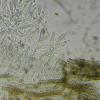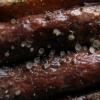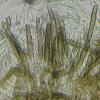
18-12-2025 17:23
 Bruno Coué
Bruno Coué
Bonjour,je serais heureux d'avoir votre avis sur c

18-12-2025 21:17
Pol DebaenstThe identification took me to Byssonectria deformi

18-12-2025 18:07
Margot en Geert VullingsThese plumes were found on rotten wood.They strong

17-12-2025 18:35
 Michel Hairaud
Michel Hairaud
Bonjour à tous/Hi to everyone I am passing along

15-12-2025 15:48
 Danny Newman
Danny Newman
Melanospora cf. lagenaria on old, rotting, fallen

15-12-2025 15:54
 Johan Boonefaes
Johan Boonefaes
Unknown anamorph found on the ground in coastal sa

15-12-2025 21:11
 Hardware Tony
Hardware Tony
Small clavate hairs, negative croziers and IKI bb

15-12-2025 07:09
 Danny Newman
Danny Newman
indet. Rutstroemiaceae sp. on unk. fallen leavesMc
Brunnipila on Ledum palustre leaves
Marja Pennanen,
29-06-2014 22:26
these brown, very small, about 0,1 mm wide, stipate ascomycetes grow on Rhododendron tomentosum (Ledum palustre) leaves. First I thought them to be Venturiocistellas, but they seem to be Brunnipilas.
The stipe is about half the height.
Spores are about 5x1,5 and asci 18-22x5-6,
The paraphyses exceeded asci about 10 micrometers and hairs are max. 50-60x3-4.
I can present no macrophoto now, maybe I'll try tomorrow.
Hope that one microphoto can tell all, that is needed for determination.
Marja
Hans-Otto Baral,
29-06-2014 22:42

Re : Brunnipila on Ledum palustre leaves
Hi Marja
I suppose a Fuscolachnum . Brunnipila is never so small, and has longer hairs which are apically densely septate, also often slightly capitate, usually with crystals.
These are the small asci on your photo, with spores hardly visible. I think Venturiocistella and Fuscolachnum are very close.
Zotto
I suppose a Fuscolachnum . Brunnipila is never so small, and has longer hairs which are apically densely septate, also often slightly capitate, usually with crystals.
These are the small asci on your photo, with spores hardly visible. I think Venturiocistella and Fuscolachnum are very close.
Zotto
Marja Pennanen,
30-06-2014 09:14
Re : Brunnipila on Ledum palustre leaves
Dear Zotto,
thank you!
Seems, that I do not find the right genera to look for determination.
Luckily I have a key for Fuscolachnum and F. dumorum may fit.
Got to spend one of the scanty collection to check, weather the hairs fit to the description.
Thankfully: Marja
thank you!
Seems, that I do not find the right genera to look for determination.
Luckily I have a key for Fuscolachnum and F. dumorum may fit.
Got to spend one of the scanty collection to check, weather the hairs fit to the description.
Thankfully: Marja
Marja Pennanen,
30-06-2014 10:27
Re : Brunnipila on Ledum palustre leaves
Hi,
Now I have made another preparate.
This is not F. dumorum.
There are at least two type of hairs, longer near the margin and shorter near the base and on the stipe.
I saw no hyaline marginal hairs, but that does not mean, that they do not exist.
But the hairs are lighter at the top and I saw no septas.
The asci are too small, up to 25x6 and paraphyses exceed asci too much and are too wide.
These are not open, when dry.
So I put: Fuscolachnum sp. on the specimen, when I pack it to my herbarium.
Marja
Now I have made another preparate.
This is not F. dumorum.
There are at least two type of hairs, longer near the margin and shorter near the base and on the stipe.
I saw no hyaline marginal hairs, but that does not mean, that they do not exist.
But the hairs are lighter at the top and I saw no septas.
The asci are too small, up to 25x6 and paraphyses exceed asci too much and are too wide.
These are not open, when dry.
So I put: Fuscolachnum sp. on the specimen, when I pack it to my herbarium.
Marja
Hans-Otto Baral,
30-06-2014 10:56

Re : Brunnipila on Ledum palustre leaves
F. dumorum is specific to Rubus and belongs indeed in Brunnipila, in my opinion. But I wonder why Huhtinen 1985 found only narrowly cylindrical paraphyses in the Phillips material (on Rubus). My collections have broadly lanceolate, strongly protruding paraphyses, as does the type of Desmazieres (drawing in Haines). So did you compare Huntinens drawing of dumorum on Ledum?
F. labradoricum would also be on Ledum but has much too large spores.
F. labradoricum would also be on Ledum but has much too large spores.
Hans-Otto Baral,
30-06-2014 11:31

Re : Brunnipila on Ledum palustre leaves
René Dougoud,
30-06-2014 17:14
Re : Brunnipila on Ledum palustre leaves
Chers Tous,
A toute fin utile, vous trouverez une clé du genre Fuscolachnum et des photos et dessins de F. dumorun, en ligne dans les archives du site Ascomycete.org.
Cordialement
René
Dougoud, R. Quatre discales récoltées sur feuilles de Rubus fructicosus, en photographies et dessins
Ascomycete.org, 3 (1) : 19-23.
Avril 2011
A toute fin utile, vous trouverez une clé du genre Fuscolachnum et des photos et dessins de F. dumorun, en ligne dans les archives du site Ascomycete.org.
Cordialement
René
Dougoud, R. Quatre discales récoltées sur feuilles de Rubus fructicosus, en photographies et dessins
Ascomycete.org, 3 (1) : 19-23.
Avril 2011
Dougoud R. Clé des espèces du genre Fuscolachnum J.H. Haines
Ascomycete.org, 3 (1) : 24.
Avril 2011
Hans-Otto Baral,
30-06-2014 17:54

Re : Brunnipila on Ledum palustre leaves
Oh yes, I forgot your nice articles. sorry.
Seems to be a difficult group, but I cannot imagine that a species on Rubus jumps on Ledum and almost nothing else. This and the question about F. dumorum and its relation to Brunnipila would be a nice matter for sequencers.
Zotto
Seems to be a difficult group, but I cannot imagine that a species on Rubus jumps on Ledum and almost nothing else. This and the question about F. dumorum and its relation to Brunnipila would be a nice matter for sequencers.
Zotto
Hans-Otto Baral,
30-06-2014 17:54

Re : Brunnipila on Ledum palustre leaves
Oh yes, I forgot your nice articles. sorry.
Seems to be a difficult group, but I cannot imagine that a species on Rubus jumps on Ledum and almost nothing else. This and the question about F. dumorum and its relation to Brunnipila would be a nice matter for sequencers.
Zotto
Seems to be a difficult group, but I cannot imagine that a species on Rubus jumps on Ledum and almost nothing else. This and the question about F. dumorum and its relation to Brunnipila would be a nice matter for sequencers.
Zotto
Marja Pennanen,
01-07-2014 21:58
Re : Brunnipila on Ledum palustre leaves
Hello again,
today after rain I went to a place, where I know Ledum palustre to grow.
I picked a lot of these and many other species (two different Lophodermiums, Lachnum, something Cistella-like, Mollisia and some pyrenomycetes) on them, too.
At this moment the species is not rare here. It might be, that nobody has occured to study Ledum leaves this early in the summer. The summer is late here, because of the coldish weather.
Fuscolachnums were open, the hymenium was almost white.
I studied one of the biggest.
The asci were now up to 30 and lanceolate paraphyses exceeded the asci even by 15 and could be wider than the asci.
But I think, that there were cylidric paraphyses, too.
I saw one almost colourless hair, 30 micrometer long.
So, if I got to choose, it is F. misellum.
I will send some to Seppo and hope, that with his equipments all the needed details can be found.
Thank you : Marja
today after rain I went to a place, where I know Ledum palustre to grow.
I picked a lot of these and many other species (two different Lophodermiums, Lachnum, something Cistella-like, Mollisia and some pyrenomycetes) on them, too.
At this moment the species is not rare here. It might be, that nobody has occured to study Ledum leaves this early in the summer. The summer is late here, because of the coldish weather.
Fuscolachnums were open, the hymenium was almost white.
I studied one of the biggest.
The asci were now up to 30 and lanceolate paraphyses exceeded the asci even by 15 and could be wider than the asci.
But I think, that there were cylidric paraphyses, too.
I saw one almost colourless hair, 30 micrometer long.
So, if I got to choose, it is F. misellum.
I will send some to Seppo and hope, that with his equipments all the needed details can be found.
Thank you : Marja
Hans-Otto Baral,
01-07-2014 22:18

Re : Brunnipila on Ledum palustre leaves
Do you mean F. dumorum? F. misellum is on ferns and has cylindrical paraphyses
Marja Pennanen,
02-07-2014 00:23
Re : Brunnipila on Ledum palustre leaves
Hi Zotto,
Haines tells, that F. misellum is on Rubus fruticulosus and Acer leaves.
Paraphyses should be narrow and only little lanceolate.
Ok, Fuscolachnum cf. dumorum then :D
That Cistellalike I found, need own threat, it is interesting.
But now I need some sleep: Marja
Haines tells, that F. misellum is on Rubus fruticulosus and Acer leaves.
Paraphyses should be narrow and only little lanceolate.
Ok, Fuscolachnum cf. dumorum then :D
That Cistellalike I found, need own threat, it is interesting.
But now I need some sleep: Marja
Hans-Otto Baral,
02-07-2014 09:44

Re : Brunnipila on Ledum palustre leaves
Ah sorry, I am confused.
Well, as stated in the brginning, I would exclude F. dumorum because it has more the characters of a Brunnipila - therefore I have it in my Brunnipila folder. But I may be wrong
Zotto
Well, as stated in the brginning, I would exclude F. dumorum because it has more the characters of a Brunnipila - therefore I have it in my Brunnipila folder. But I may be wrong
Zotto



